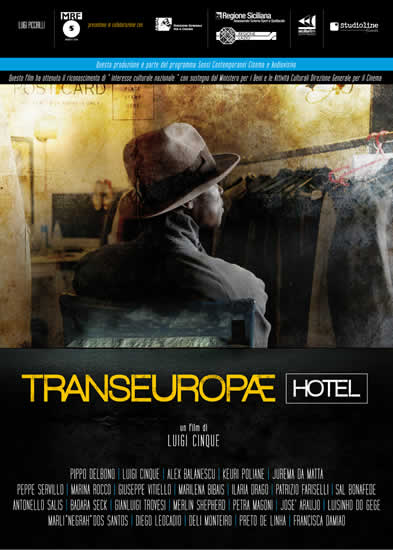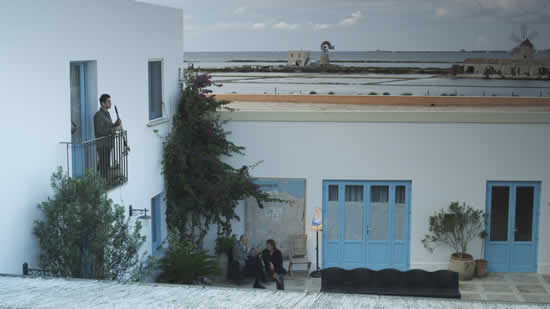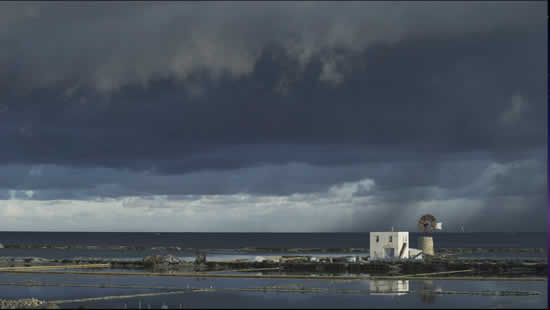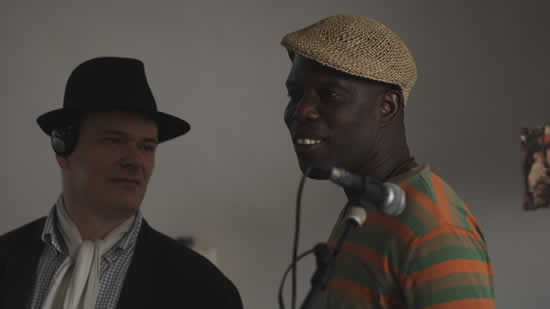 In a hotel on the west coast of Sicily a group of international jazz artists are rehearsing and getting ready to go on tour. As they are preparing, two women from the favelas of Rio show up. The women tell the musicians that Darcy, a famous percussionist and old friend of the bandleader has gone missing and they believe that a witchdoctor, paid by drug smugglers, is responsible. One thing is clear: Darcy must be found. The musicians finally figure out, after much consideration, what to do; and the bandleader and an actor set out in search of the Candomblé priest.
In a hotel on the west coast of Sicily a group of international jazz artists are rehearsing and getting ready to go on tour. As they are preparing, two women from the favelas of Rio show up. The women tell the musicians that Darcy, a famous percussionist and old friend of the bandleader has gone missing and they believe that a witchdoctor, paid by drug smugglers, is responsible. One thing is clear: Darcy must be found. The musicians finally figure out, after much consideration, what to do; and the bandleader and an actor set out in search of the Candomblé priest.
Experience a road movie from the west coast of Sicily to the favelas of Rio de Janeiro and Salvador Bahia. It is a quest to uncover their musical formula and to retrieve a lost friend. As the adventure proceeds, the rest of the group waits at the TRANSEUROPAE HOTELl and unwittingly get swept up in the drama, like a tragic Greek chorus. This poetically picaresque adventures abound in Brazil and in Sicily, ending in the grand final ethno-jazz concert.
Written and directed by Luigi Cinque according to the narrative principles of melodrama, TRANSEUROPAE HOTEL is an art house film. The music is the object, and in a sense, the subject of the film. But there is also something more. Thanks to the tight screenwriting, the story unfolds in a symbolic – otherworldly way, defining itself as fable-like film noir.
TRANSEUROPAE HOTEL, it could be said, is also a meditation on contemporary life, on our maladjustment. It is a meditation on our value of music (and poetry), on the co-existence (the saving grace!) of magical and rational thinking, on the belief that other worlds are possible. And finally it is a meditation on our present danger of losing our self determination.
The main characters of the movie are played by themselves creating a sort of narration that, rather than documentary (or mockumentary style), is inspired by post-neorealism criteria.
Luigi Cinque, director of TRANSEUROPAE HOTEL is an Instrumentalist and composer of classic, folk and jazz music. A long-time collaborator with avant-garde theatre, poetry, visual art and new  European dance, together with Carlo Quartucci, Pina Bausch, Jannis Kounellis, Bonito Oliva, Nanni Balestrini, Vs Naipaul, Paco Taibo II, Aldo Nove. He has written and directed contemporary works in Rome, Rio de Janeiro, Jakarta, Sydney, Tokyo, Nairobi, Dakar, Tel Aviv, and Moscow. Advertising campaigns include CRAMPS, Memories, BMG, MRF, Fandango, EMI, and Warner.
European dance, together with Carlo Quartucci, Pina Bausch, Jannis Kounellis, Bonito Oliva, Nanni Balestrini, Vs Naipaul, Paco Taibo II, Aldo Nove. He has written and directed contemporary works in Rome, Rio de Janeiro, Jakarta, Sydney, Tokyo, Nairobi, Dakar, Tel Aviv, and Moscow. Advertising campaigns include CRAMPS, Memories, BMG, MRF, Fandango, EMI, and Warner.
In 2003, the disc Tangerine Café won the International Critics’ Award for Best World Music Album. His current musical project is the Hypertext O’rchestra. He has directed work for Rai and Arte France as well as in Canada and Spain. After diverse docs, TRANSEUROPAE HOTEL is his first feature film.
Bijan Tehrani: What inspired you to make TRANSEUROPAE HOTEL?
Luigi Cinque: There are diverse motivations. In any case, as we all know, an idea, an inspiration, are results of many factors and experiences accumulated over time. Then, above and beyond this, there’s the element of Chance, Co-incidences which are, in fact not coincidental. I’m primarily a musician rather than video maker, and when our film project was initially financed and crystallized into reality, I took it as a challenge. The challenge of dealing with a close-ended narration defined inside a predetermined time span, passing from ‘the language of signifiers’ of music to a language of the‘meanings’, to insert into ‘the time of possible meanings’, a metafisical story, in a certain sense. Yes! because the three story lines which inspired the film must ( and can ) be integrated into a single metaphysical dimension. The film talks of music as an evoluted form of molecular vibration, of a man who disappears because of magic, of quantum physics which (like certain forms of magic) links molecular vibrations and the positioning of solid bodies in other parallel dimensions, and lastly a picaresque research that takes the form of a ‘film noir’ and, at the same time, of a road movie.
BT: Watching TRANSEUROPAE HOTEL twice, it gives the same feeling as reading a Gabriel Garcia Marquez book, how did you come up with the screenplay of the film?
LC: Starting from narrative idea which is, more or less, this: An hotel on the west coast of Sicily. A group of international jazz artists are rehearsing and getting ready to go on tour. As they are preparing, two women from the favelas of Rio show up. The women tell the musicians that Darcy, a famous percussionist and  old friend of the bandleader has gone missing and they believe that a witchdoctor, paid by drug smugglers, is responsible. One thing is clear: Darcy must be found. The musicians finally figure out, after much consideration, what to do; and the bandleader and an actor ( only these can ) set out in search of the Candomblé priest. From Sicily to Brasil and back…
old friend of the bandleader has gone missing and they believe that a witchdoctor, paid by drug smugglers, is responsible. One thing is clear: Darcy must be found. The musicians finally figure out, after much consideration, what to do; and the bandleader and an actor ( only these can ) set out in search of the Candomblé priest. From Sicily to Brasil and back…
This is the basis for the story outline. From this point onwards the screenplay developed in three distinct phases. The first was locking ourselves off in a room writing creatively, imagining and developing the structural passages of the storyline, the successive phase was during the shooting itself and consisted of layering the story with improvisation , and the third, the writing of the lyrical narrative voice over, with the collaboration of the poet Valerio Magrelli.
BT: The characters in TRANSEUROPAE HOTEL are very interesting, while they are quite real, they also give you the feeling that they are characters of a dream, how did you develop the characters of the film?
LC: I think that the answer to your question is that essentially the characters in the film are above all artists and not actors, and for the most part musicians, so the scenes recall a sort of modern neorealism, ( I should say an iperneo-realism ) that defines a loss of centrality, between truth and fiction. This functions as a masking of their essence to the point of blurring them, leaving the characters undefined thus allowing them to become more lyrical. Perhaps this is the stepping off point that creates that atmosphere evoked by Garcia Marquez’s writings, an association which I consider both a great and undeserved honor. In this sense my film creates a form of ‘magic iper/ neorealism’
BT: Locations in your film are as important as your characters, how did you pick the locations?
LC: We wanted to match up two points of the earth, that in some ways shared the same type of light, but at the same time were distinctive, in the sense that they both convey two different settings or atmospheres, but are unified in driving the narrative. In Sicily we have a Mediterranean landscape ( wide, desert, the white of the salt fields) that functions as a container for this group of musicians that sit and wait, while at the same time developing a semblance to a choir of Sophocles or Shakespeare.
Instead in Brazil, Rio’s favela and the Cadomble of Salvador Bahia are the locations devoted to the leading characters’ action or dynamism, they’re the other side, the ‘alterita’ , the nightmare, the dream, the foreigner. In the end, the two locations should give the spectator, the sensation, the memory that recomposes itself in a single metaphysical light.
BT: TRANSEUROPAE HOTEL is not the kind of musical film we are used to watch, but music is blended into the structure of the film, how challenging was to make this happen?
LC: Two things that I find particularly interesting about this film and that characterize it. The first is that all the cast are in some way artists rather than actors, who infuse into their performances a form of contemporary neorealism, which I call hyperneorealism. The second point is to have a direct crossover orienting the scenes and actors in a manner reminiscent of musical interplay, with the same concept and needs shared during a session of musical improvisation. I’m referring, of course, to a group of musicians which share a mutual affinity. This is what I felt happened in this film. So, by having musicians who appear in the film as key actors, living their experiences while developing the narrative, and at the same time playing their instruments ( filmed during a rehearsal for the concert finale) their philosophy is the same. They’re born of the same essence, the same fibre. On the other hand, improvisation is the opposite of prediction , and predicting substantially implys being close to things, being in direct contact with the material part of music and narration as it happens. This film is lived and directed as if it were a musical score.
 BT: Please tell us about casting of your film.
BT: Please tell us about casting of your film.
LC: The cast is truly extraordinary. In the cast there’s my musician friends, veterans of concerti adventures, and great talents none of which were ever screen actors, amongst whom, Pippo Delbono who comes from contemporary theatre. Even in Brazil in the casting sessions, I sought out actors who were in some ways, characters in real life. Characters that could accompany the narrative of the film along its journey, and travel a piece of the road together
BT: TRANSEUROPAE HOTEL has three cinematographers, but it has a unified visual style, how you accomplished that and how did you decide about the look of your film?
LC: The fact that the film has three Directors of Photography was totally unplanned. In hindsight however I’ve discovered a methodology which I’ll probably use in future projects. A specialist for each ambience.I’d also like to add that in the film, the directors of photography are also camera operators. This choice was not neciessarily dictated by the econmic constraints of a low budget film.For instance, Renaud Personnaz with his sensitive touch, shot the ambience in the Sicilian portion of the show, very pictorial . Jacques Cheique, an extraordinary carioca photographer, captured movement and action in Brazil. The youngest, Michele Cinque photographed the pieces with pure movement as a theme, a psychological study of the relationship between movement and music. He also shot second unit in Sicily, set free from the principal unit doing pictorial photography to contribute B/cam ambience. The second camera in Brazil was shot by Giorgio Bottos, himself a director and director of photography on his own right.
BT: Please tell us about your future projects.
LC: Although I continue to make my music, I’m thinking that the narrative structure of the film invites the possibility of a sequel, not necessarily made for TV….we’re working on it and openly looking for both creative and financial partners. I’m, of course open to offers !

